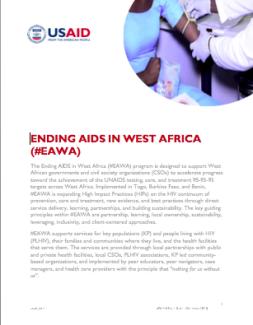The Ending AIDS in West Africa (#EAWA) program is designed to support West African governments and civil society organizations (CSOs) to accelerate progress toward the achievement of the UNAIDS testing, care, and treatment 95-95-95 targets across West Africa. Implemented in Togo, Burkina Faso, and Benin, #EAWA is expanding High Impact Practices (HIPs) on the HIV continuum of prevention, care and treatment, new evidence, and best practices through direct service delivery, learning, partnerships, and building sustainability. The key guiding principles within #EAWA are partnership, learning, local ownership, sustainability, leveraging, inclusivity, and client-centered approaches.
#EAWA supports services for key populations (KP) and people living with HIV (PLHIV), their families and communities where they live, and the health facilities that serve them. The services are provided through local partnerships with public and private health facilities, local CSOs, PLHIV associations, KP led community-based organizations, and implemented by peer educators, peer navigators, case managers, and health care providers with the principle that “nothing for us without us”.
PROGRAM ACTIVITIES
Comprehensive HIV service delivery at the community and health facility level:
- Conducts interventions to reduce new HIV infections (access to condoms and lubricants, pre-exposure prophylaxis, gender-based violence prevention and response).
- Targets HIV testing (index testing, Enhanced Peer Outreach Approach, risk network referral, self-testing, targeted provider-initiated testing, and counseling).
- Improves the initiation, and linkages to treatment (test and start, peer navigation).
- Improves long-term continuity on treatment.
- Implements differentiated models of care approach, including multi-month dispensing.
- Accelerates TLD Transition (a combination of three drugs to attack and defeat the virus).
- Improves viral load (VL) demand and suppression.
- Improves data quality and data use for decision making.
Lab system strengthening
- Strengthens VL specimen collection, transport networks and VL laboratory capacity.
- Strengthens laboratory quality and adherence to quality systems guidelines.
- Facilitates laboratory participation in proficiency testing and external quality improvement.
Partnerships
- Empowers local CSOs.
- Works with South-to-South learning.
EXPECTED RESULTS
- 95 percent of PLHIV across all subpopulations, age groups, and sexes know their HIV status.
- 95 percent of PLHIV who know their status are accessing life saving antiretroviral therapy.
- 95 percent of PLHIV who are on antiretroviral therapy are virally suppressed.
- Expanded HIV high impact practices (HIPs) in the West Africa Region.
- Strengthened capacities of local partners (CSOs, associations/networks of key populations and PLHIV, public and private health facilities).
PROGRAM INFORMATION
Goal: Achieve HIV epidemic control in West Africa by accelerating progress across the region toward ending AIDS through prevention, care, and treatment services, and accelerating the achievement of UNAIDS 95-95-95 targets within all subpopulations including key populations, all age groups, and geographic settings.
Life of Program: September 2017 – September 2026
Total USAID Funding: $76.2 million
Geographic Focus: Togo, Burkina, and Benin
Implementing Partner: Prime Recipient – FHI 360; Sub-recipients – Public and private health facilities, Local CSOs, Associations of KPs and PLHIV, National Aids Contol Program (NACP)

